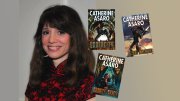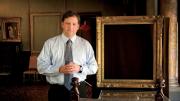Looking back, it seems obvious now that science fiction was going to win out for Catherine Asaro, Ph.D. ’85. By the time she sat down in graduate school to write the first book in what would become her long-running Skolian Empire saga—about an interstellar civilization of warrior queens and biologically enhanced empaths locked in perpetual battle with their slave-trading enemies—the story had been rattling around in her head for almost 20 years. And not just the basic outlines, but deep-in-the-weeds details about romantic entanglements, political intrigues, and entire Skolian family trees. “I’ve been making up these stories since I was two years old,” says Asaro, who as a child used to sneak into her older brother’s room to read his science fiction magazines. “At first, I made up stories about little girls going off into space with their cats. And there was a cat planet, of course,” inhabited by blue and green felines. Then, when puberty hit, “the cats were replaced by a handsome young pilot.”
But it took some years for Asaro to figure out how to actually get the stories down on paper. And in the meantime, she became a musician, dancer, and scientist. She learned to play classical piano. At five years old, after seeing a performance of Swan Lake, she started training to be a professional ballerina and arrived at the University of California, Los Angeles, as a dance major, before switching to chemistry during her sophomore year. Later, as a Ph.D. student, she founded two campus ensembles, the Harvard University Ballet and the Mainly Jazz Dance Company, both of which still perform.
Science—Asaro’s other abiding fascination—ran in the family. Her father was Frank Asaro, a Berkeley nuclear chemist who helped conceive the asteroid theory of dinosaur extinction. He sometimes brought Asaro and her sister to his lab, although back then, she says, girls weren’t encouraged to pursue science. Still, a fascination took root and never really let go. She remembers stumbling across quantum mechanics in an undergraduate honors chemistry course and then spending an entire day and night at the UCLA physics library, reading everything she could find on the subject, until suddenly she realized all the other students had gone and a security guard was tapping her on the shoulder to say the library was closed. After earning her bachelor’s degree in chemistry, she came to Harvard for a doctorate in chemical physics, expecting a career in academia.
That career didn’t stick. She spent three years on the faculty at Kenyon College in Ohio (“Beautiful place, I loved it there”), but by then she’d begun writing science fiction and discovered that she didn’t really want to do anything else. So, she quit to pursue it full time. It was a leap: she was nine months pregnant with her daughter, and both she and her husband, an astrophysicist, had to leave their jobs at Kenyon. When he later found work at NASA’s Goddard Space Flight Center, the family settled in Maryland. In 1995, after publishing a handful of short stories, Asaro released her first novel, Primary Inversion. Set amid a three-way war for control of human civilization across space, it revolved around a protagonist called Soz, a female fighter pilot and member of the Skolian Empire’s ruling dynasty.
Since then, she has produced more than 30 novels, including 18 in the Skolian Empire series. (And she didn’t leave teaching behind altogether: for nearly two decades, until 2019, her side job was running a math tutoring program out of her home, where her highly sought-after classes helped high school students qualify for the USA Mathematical Olympiad and win scholarships to universities like Stanford and MIT.) Asaro’s writing has won two Nebula Awards, the top prize in science fiction and fantasy. Her work is known for its feminist themes and strong female characters—the Skolian Empire is ruled by women—and for incorporating hard science into complex and winding romance narratives. She’s written academic papers on the theoretical concepts undergirding her plotlines, including one titled “Complex Speeds and Special Relativity,” published in 1996 in the American Journal of Physics. It worked through the mathematical equations, involving tachyons and complex numbers, that would enable her books’ starships to travel faster than the speed of light.
“You know, I wouldn’t have expected someone with a mind like mine to become a writer,” says Asaro, who found out later in life that she has dyslexia, a discovery that explained why she’d always struggled to get her reading done in school—and why the clarity of science and mathematics had appealed to her so strongly. But writing “took over from day one,” she says. “It just felt natural to me.” In part, that’s because writing on a computer enables her to transpose words and move blocks of text around—“I don’t think I could do this otherwise”—and in part, it’s because of the way she approaches her narratives. “When you have a scientific problem you’re solving in your fiction, it’s like a riddle that the characters have to figure out,” she says. “To me, the emotional part of the story is another thing they’ve got to figure out. It’s just another problem to be solved.”
Lately, Asaro has been doing problem-solving in a new series of novels, the Major Bhaajan Mysteries, set in the Skolian universe and centered on a female military commander turned private detective who egrew up in the Undercity, a slum hidden in the ancient ruins beneath the glittering metropolis of the empire’s ruling elite. Last year, Asaro published the fourth book in the series, The Jigsaw Assassin, in which the murders of three prominent scientists lead Major Bhaajan and the Dust Knights—her Undercity crew of martial arts fighters—to a conspiracy at the highest reaches of political power. Like many of her books, this one began with little more on paper than an outline and an idea. “The story came as I wrote it,” says Asaro, who is already at work on two future books, one of them a spinoff about the Dust Knights. “I’ve been imagining these universes forever, and they’ve gotten very complex. But every time, the pieces fit together.”








